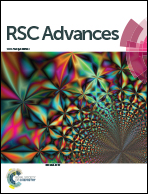A simple colorimetric and ratiometric fluoride ion probe with large color change†
Abstract
Two colorimetric and ratiometric fluoride ion probes SHJ-1 and SHJ-2 based on the acylhydrazone skeleton have been developed. Among the eight anions (F−, Cl−, Br−, I−, ClO4−, H2PO4−, HSO4−, CH3COO−), the present probes showed high selectivity and sensitivity toward fluoride ion detection with obvious color change. Notably, the probe SHJ-1 exhibited a red shift of 145 nm upon fluoride sensing, which is the largest value among fluoride ion probes based on acylhydrazone derivates to date. 1HNMR titration study and theoretical calculations suggested that the strong binding of the probe SHJ-1 to fluoride as well as the further deprotonation may facilitate the intramolecular charge transfer transition. These two probes are 1 : 1 complexed with fluoride ions, and the detection limits were calculated to be 1.24 μM for SHJ-1 and 15.73 μM for SHJ-2.



 Please wait while we load your content...
Please wait while we load your content...